Planetizen's annual list of the top urban planning books of the year is here—maintaining a tradition that dates back to 2002.

We've arrived at the end of another pandemic year. While 2020 was full of apprehension and uncertainty, 2021 seems more likely to come to be defined by hope giving way to disappointment. But the world is still waiting to discover the long-term effects of the pandemic, and with so much focus currently on the global supply chain, gas prices, and endemicity (rather than herd immunity), many of the worst fears of spring 2020 still seem in play.
Still to come also, it seems, is a definitive text about the pandemic and its effects on the field of planning. In the books that follow, we see the pandemic mentioned in forewords and afterwords, or sprinkled in here and there, but if you’re looking for ambitious non-fiction to help wrap your head around the consequences of this unfolding moment in history, you’ll probably still need to reference books that predate the novel Coronavirus—The Great Influenza by John M. Barry and A Paradise Built in Hell by Rebecca Solnit come to mind. Eventually this pandemic will be endemic, and many books will emerge with the brilliant planning analysis we’ve all craved for nearly 21 months now. Those books will require more patience, just like so much else of the experience of surviving COVID-19.
But the lack of a definitive pandemic planning tome does not mean that 2021 didn’t offer plenty of reading material for improving our skills as humans and planners both during and after the pandemic. The Planetizen team met in October and November 2021 to make final selections for this list according to the same selection criteria that guided similar "Top Books" lists from years past (2019 and 2020 were both great years for planning books, in case you're still looking to catch up as the pandemic lingers into yet another new year). All books on this list were published between roughly September 2020 and September 2021, although there is at least one exception on the edges of that range (and likely will be next year too). Any big titles that just missed the window will be considered for next year's list.
The Top Urban Planning Books of 2021
Confessions of a Recovering Engineer: Transportation for a Strong Town
Charles Marohn
Willey
September 2021, 272 Pages
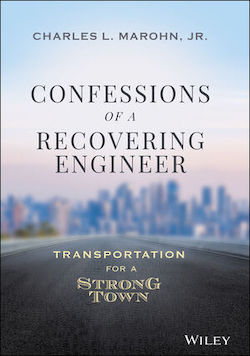 Most Americans go their whole lives without sparing a single thought for the formulas and measurements of traffic control. All that car traffic, moving all the time, might seem like a miracle. As Charles Marohn reveals in Confessions of a Recovering Engineer, the choices (planning, engineering, and political) behind the dominant mode of transportation in the United States are more magical thinking than miracle.
Most Americans go their whole lives without sparing a single thought for the formulas and measurements of traffic control. All that car traffic, moving all the time, might seem like a miracle. As Charles Marohn reveals in Confessions of a Recovering Engineer, the choices (planning, engineering, and political) behind the dominant mode of transportation in the United States are more magical thinking than miracle.
Part of the genius of Confessions is its air of whispered exposé, or the clandestine document of a whistleblower. Marohn has been on the other side of these equations, following the doctrine (dogma) of a profession that obstinately refuses to acknowledge the costs, in lives, of its single mindedness. Marohn has also been penalized for calling that dogma into question, which adds to the intrigue.
Marohn’s skills in making planning and engineering jargon relatable—with anecdote, metaphor, and rhetoric—are paralleled only by Donald Shoup. The comparison can be taken a step further: Confessions promises to take position next to Right of Way (Top Planning Books 2020), the High Cost of Free Parking (Top Planning Books 2006) and Walkable City (Top Planning Books of the 2010s) as the essential planning texts for resisting automobile dominance.
If you’re already outraged at the state of traffic safety in the United States, Confessions is the perfect book for informing yourself and others to make a change. If you’re not yet outraged, prepare to be.
Freedom to Discriminate: How Realtors Conspired to Segregate Housing and Divide America
Gene Slater
Heyday
September 2021, 480 Pages
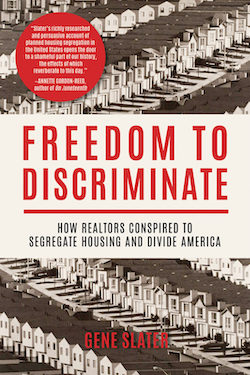 Every planner knows the story of redlining: in brief, maps created by the New Deal-era Home Owners' Loan Corporation (HOLC) led private banks to deny mortgages in neighborhoods deemed 'hazardous' for lenders and effectively barred many Black families from purchasing homes, plunging neighborhoods into decades of disinvestment. Fewer know the instrumental role played by realtors, primarily in California, in shaping the institutions that perpetuated racial discrimination and transformed the conservative narrative in the United States.
Every planner knows the story of redlining: in brief, maps created by the New Deal-era Home Owners' Loan Corporation (HOLC) led private banks to deny mortgages in neighborhoods deemed 'hazardous' for lenders and effectively barred many Black families from purchasing homes, plunging neighborhoods into decades of disinvestment. Fewer know the instrumental role played by realtors, primarily in California, in shaping the institutions that perpetuated racial discrimination and transformed the conservative narrative in the United States.
Freedom to Discriminate: How Realtors Conspired to Segregate Housing and Divide America charts the insidious campaign led by California realtors to institutionalize housing discrimination, couching it in the language of civil rights and coopting the concept of freedom. Author Gene Slater connects the realtors’ campaign to the modern conservative movement, arguing that it essentially created the language used today to justify a variety of perceived rights that in fact infringe on the freedom of minority groups.
Using confidential documents and communications between real estate industry leaders, Slater shows how the California realtor lobby conspired to legalize residential discrimination and entrench the freedom to exclude as an essential American right tied to the sanctity of private property. Through their support of California's Proposition 14 and then-governor Ronald Reagan, realtors built a discriminatory system that had a lasting impact on the entire country.
Slater shows how the realtor lobby invoked freedom and consumer choice to curtail the freedom of certain groups even after racial covenants became illegal. The purportedly "color-blind" language used by the realtors, Slater notes, "effectively prioritized the freedom of certain Americans without directly saying so." The campaign presented freedom as a limited, individual possession, and in this way created a false sense of scarcity.
Freedom to Discriminate is a thorough, searing indictment that reminds the reader of the historical forces that have shaped U.S. housing policy and illuminates a dark chapter that has largely, until now, remained in the shadows.
Hip Hop Architecture.
Sekou Cooke
Bloomsbury
April 2021, 288 Pages
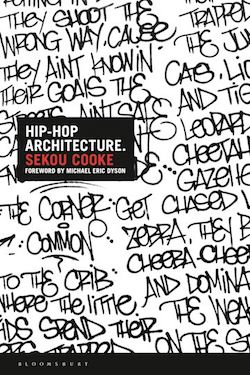 The project of Hip Hop Architecture., by Sekou Cooke, clicked for this novice reader of hip hop architecture theory somewhere in the middle of the book’s second volume, when the author describes the various techniques of DJing—shoutout, crate digging, mixing, remix, mixtape, and sample. The author’s own crate digging, defined as continual research, is obvious—archival detail like the lyrics to songs by Lupe Fiasco, Nas, Common, and Mos Def mix with references from deeply esoteric moments in academic history (the 2010 Conference on College Composition and Communication, anyone?). Cooke’s remix tills exceptionally fertile intellectual ground by comparing the concepts and contradictions of hip hop to the world of architecture.
The project of Hip Hop Architecture., by Sekou Cooke, clicked for this novice reader of hip hop architecture theory somewhere in the middle of the book’s second volume, when the author describes the various techniques of DJing—shoutout, crate digging, mixing, remix, mixtape, and sample. The author’s own crate digging, defined as continual research, is obvious—archival detail like the lyrics to songs by Lupe Fiasco, Nas, Common, and Mos Def mix with references from deeply esoteric moments in academic history (the 2010 Conference on College Composition and Communication, anyone?). Cooke’s remix tills exceptionally fertile intellectual ground by comparing the concepts and contradictions of hip hop to the world of architecture.
And planning. When Cooke invites the reader to compare b-boys to architecture and asks the reader to “Imagine the kinds of built environments that would warrant such a description,” the book’s purview expands far beyond the mere design of buildings. “Hip Hop Architects must continue to use resistance to shape their attitudes toward technology,” pleads Cooke, and the word planning is easily implied. "Hip hop provides a welcome antithesis to the grid’s legacy and holds the power to coopt architecture from its affluent, White, male figureheads who continue to profess neutrality and universality." Mic drop.
The completely uninitiated should read Jeff Chang's Can't Stop, Won’t Stop (an unequivocal recommendation whether you intend to read Hip Hop Architecture., or not). Like with Chang's work, Cooke offers a rare chance to learn and explore hip hop history while learning and exploring major moments in the history of hip hop architecture. The same goes for the major theoretical debates of hip hop and hip hop architecture theory.
Cooke easily answers the question of whether hip hip culture expresses itself within the built environment. The project now is how to enshrine Hip Hop Architecture within the canon of planning and architecture theory and ensure permanent influence on the theory and practices of the built environment.
The Invention of Public Space: Designing for Inclusion in Lindsay’s New York
Mariana Mogilevuch
University of Minnesota Press
August 2020, 240 Pages
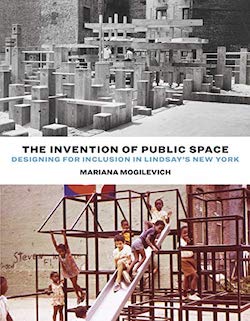 If you're in a planning or urban design career to better the world, it’s nice to know that other people—in similar positions, for similar organizations, working with similar constraints—have previously made significant progress toward similar goals. While some of these examples have achieved fame beyond reasonable expectation while pursuing their vision for cities—Jane Jacobs, Daniel Burnham, William Whyte, Jan Gehl, and Andrés Duany come immediately to mind, for better or worse—some examples of lasting influence are relatively unknown in the annals of planning history.
If you're in a planning or urban design career to better the world, it’s nice to know that other people—in similar positions, for similar organizations, working with similar constraints—have previously made significant progress toward similar goals. While some of these examples have achieved fame beyond reasonable expectation while pursuing their vision for cities—Jane Jacobs, Daniel Burnham, William Whyte, Jan Gehl, and Andrés Duany come immediately to mind, for better or worse—some examples of lasting influence are relatively unknown in the annals of planning history.
It just fits, then, that Mariana Mogilevuch opens The Invention of Public Space with an anecdote about William Whyte’s film, "The Social Life of Small Urban Places," but quickly reveals that we probably don’t know the whole story. It’s a pleasant surprise to discover how fresh and new some of the ideas discussed in the film were at the time of production—we're talking about public space, a term so commonplace and so fundamental to contemporary planning practice that it’s hard to get through a Next City or a CityLab post without reading those exact words. As Mogilevuch makes clear, much of what we now take as a given about the planning and designing of public space was invented as the manifestation of very specific sociological concepts, in a singular political milieu, and in response to a historic and lasting urban crisis.
The ambition of the story told in these pages is redoubled when compared to the traditional portrayal of New York City in the late '60s and early '70s in popular culture and planning history—where the story usually focuses on white flight or turf wars. The Invention of Public Space shifts the focus to a rotating group of ambitious, well intentioned people, reinventing concepts of public works and of public space with the full support of the Lindsay administration. The book doesn’t need to shy away from policy and the design details: what normally might seem like nitty gritty reserved for the most esoteric audiences are accessible and familiar.
It almost seems possible that the progressive planning and design ideals invented during this time, by these planners, designers, and politicians, outlived white terror. Almost. While reading these stories of designers creating space for self-determination and social interaction—opening the public realm to a much more diverse group of city dwellers—we also must face the blunt reality that many cities are currently moving in the opposite direction of the example set by the Lindsay administration. Los Angeles, in the most infamous example, continues to fence off the city’s most treasured parks and sweep up homeless encampments preferred anti-homeless measures. With this context in mind, The Invention of Public Space is not only an act of archaeology, unearthing and shining light on an under-appreciated chapter of planning history, but also a reminder that a determined humanism is possible in the face of crisis.
Land: How the Hunger for Ownership Shaped the Modern World
Simon Winchester
HarperCollins
January 2021, 416 Pages
 Planners tend to think of land in concrete terms: as the medium for zoning, building, (sometimes) conservation, and so forth. But the concept of land as a commodity, thing of value, and object of control—by private, public, or corporate ownership—is generally an article of faith. In Land, Simon Wincheser explores the complex, and often disturbing, nature of land ownership around the world and throughout history.
Planners tend to think of land in concrete terms: as the medium for zoning, building, (sometimes) conservation, and so forth. But the concept of land as a commodity, thing of value, and object of control—by private, public, or corporate ownership—is generally an article of faith. In Land, Simon Wincheser explores the complex, and often disturbing, nature of land ownership around the world and throughout history.
In cataloging land use regimes and curious anecdotes—many of them harrowing—Winchester does not so much present a unified thesis of global land ownership so much as he proves that land is, well, interesting. His premise, which is nothing if not axiomatic, is that land ownership entails the awkward grafting of money and paperwork to something tangible, unique, and, mostly, immutable. The result is an infinite array of interpretations, permutations, and conflicts over who owns, governs, and uses the world's 52 billion acres. The sum total of all of this, from ancient Britain, where two farmers hashed out a boundary line millennia ago, to the modern American West, where a discomfiting class of American oligarchs measure their holdings by the millions of acres, is that, for the most part, land ownership is a scheme that helps the rich and powerful become ever more rich and powerful.
For urban planners working on local issues, with local people, Winchester implicitly begs for a reconsideration of the relationship between land and influence. Even if we agree that a homeowner's property is their castle, is the homeowner necessarily entitled to weigh in on, much less decide on, what happens on adjacent properties? And, of course, Winchester reminds us that even a home that is deeded and duly paid for was, initially, stolen from people who had essentially no concept of land ownership (and not enough firepower to defend their land).
Metropolis: A History of the City, Humankind’s Greatest Invention
Ben Wilson
Doubleday
October 2020, 464 Pages
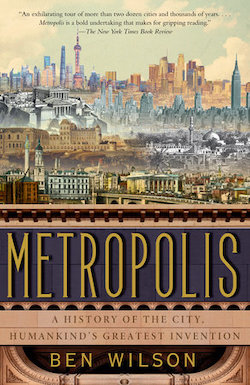 In this ambitious, and ambitiously titled book, historian Ben Wilson chooses what he considers two-dozen crucial examples of urbanism from the dawn of history onward to resurrect and analyze. He presents the cities chronologically, according to their respective heydays. If that was all he did, Metropolis might read like a series of Wikipedia entries. Instead, he manages to relate almost every city, including those from antiquity, to an enduring theme in urbanism.
In this ambitious, and ambitiously titled book, historian Ben Wilson chooses what he considers two-dozen crucial examples of urbanism from the dawn of history onward to resurrect and analyze. He presents the cities chronologically, according to their respective heydays. If that was all he did, Metropolis might read like a series of Wikipedia entries. Instead, he manages to relate almost every city, including those from antiquity, to an enduring theme in urbanism.
As Wilson describes it, Metropolis begins with sensuality, moves to socializing, politics, and technology. It's not a bad way to tell the history of humanity. We get the invention of urbanism in Uruk but also an exposition of the "Epic of Gilgamesh." Ancient Babylon and Baghdad stand, respectively, for sin and gastronomy. We get war, global trade, and imperialism in Lübeck, Lisbon, and Rome. And, more recently, we get industrialization in Manchester, destruction in Warsaw, sprawl in Los Angeles, and hypertrophy in Lagos.
Wilson's most impressive trick, in addition to his impressively broad command of both political and cultural history—is his ability to connect the past to the present. That's why Korea's ultra-modern Songdo appears on the same page as Harappa and why his description of London's friendly coffee houses could just as easily apply to Seattle or Brooklyn today.
Unavoidably, Wilson does his share of stereotyping. But he's smart enough to know that no city embodies any one thing—he just zeros in on what he considers the most important, historically significant aspects of his chosen cities and manages to make each of them relevant to today. And, he moves about the world almost effortlessly; his chapter on Los Angeles, for instance, is as insightful as anything ever written by a local.
The Ministry for the Future
Kim Stanley Robinson
Orbit Books
October 2020, 576 Pages
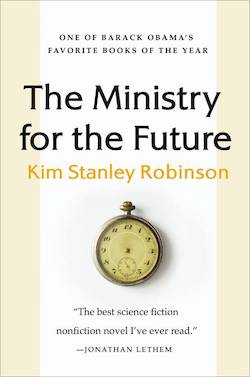 The Ministry for the Future marks the first appearance of a work of fiction on the Planetizen Top Books list in recent memory, but describing this book as any one genre is too reductive to be fair. The book includes nature writing, science fiction, and creative exposition. Throughout the genre-shifting, Robinson grounds the book in a holistic vision for the future of a world in the grips of climate change. It takes a mode of imagination that borders on science fiction (and a publishing house that mostly produces hard sci-fi) to imagine a humanity actually doing something to end climate emissions and reverse the effects of sea-level rise, mass migration, and extreme weather.
The Ministry for the Future marks the first appearance of a work of fiction on the Planetizen Top Books list in recent memory, but describing this book as any one genre is too reductive to be fair. The book includes nature writing, science fiction, and creative exposition. Throughout the genre-shifting, Robinson grounds the book in a holistic vision for the future of a world in the grips of climate change. It takes a mode of imagination that borders on science fiction (and a publishing house that mostly produces hard sci-fi) to imagine a humanity actually doing something to end climate emissions and reverse the effects of sea-level rise, mass migration, and extreme weather.
An opening passage about a heat wave in Northern India that kills 20 million people is so effectively brutal that it’s hard to imagine the reader making it through the chapter without immediately reconsidering their lifestyle choices. The chapter about a protracted drought was almost too much for this reader, living in Southern California, to bear. Comparisons to Octavia Butler and Margaret Atwood will be common—though, to be clear, Robinson lacks those writers' superlative writing chops.
The book can be classified as a planning book because like any good planning effort, it moves from assessment, to vision making, to implementation. The book’s vignette-style chapters allow for quick transition between each of these modes, creating a holistic, expansive view of climate change. You'll look into corners of the world and a changing climate that you never imagined as consequences for your daily choices in diet, mobility, or consumption.
The book is far from perfect—some sentences are begging for an editor, a few central concepts are underdeveloped for the sake of the plot, the author doesn’t pretend an ounce of patience for capitalism (anti-capitalist sympathies are thus a prerequisite for reading), and any hesitation about eco-fascism is dismissed with paltry attention to its consequences. But a hopeful vision of the future planet emerges amidst the wreckage. Generations of toil, drastic reductions in carbon burning, deep commitments to biodiversity (Half Earth is invoked throughout), political violence, and geoengineering projects larger than any public works program ever undertaken by humans are all involved in the project of saving the world. The Ministry for the Future is a brutal, unflinching, if sometimes clumsy, call to action.
Preserving Los Angeles
Ken Bernstein
Angel City Press
April 2021, 256 Pages
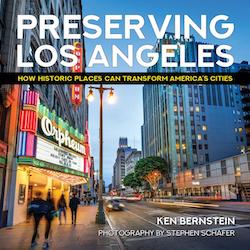 Every city should have a beautiful book that completely explains the legal and conceptual framework of historic preservation, while, along the way, celebrating that city's unique cultural heritage. Even in the cities that already have such a book, but Preserving Los Angeles has several other bonafides contributing to its excellence. First of all, there are precious few people in the city of 4 million more qualified to tell this story than Ken Bernstein, the author of the book and the long-time head of the Office of Historic Resources in the Los Angeles Department of City Planning.
Every city should have a beautiful book that completely explains the legal and conceptual framework of historic preservation, while, along the way, celebrating that city's unique cultural heritage. Even in the cities that already have such a book, but Preserving Los Angeles has several other bonafides contributing to its excellence. First of all, there are precious few people in the city of 4 million more qualified to tell this story than Ken Bernstein, the author of the book and the long-time head of the Office of Historic Resources in the Los Angeles Department of City Planning.
Second, and most important, is Los Angeles' singular cultural diversity. As acknowledged in the first paragraph of the book, explaining the cultural significance of Los Angeles to outsiders can be a challenge given the numerous, and only occasionally accurate, stereotypes about the city. Evidence that complicates these stereotypes are found frequently in Preserving Los Angeles, for example, with regard to the city's long history of preservation. Despite its reputation as a city of perpetual change and superficial edifices (literal and metaphorical), the city’s Cultural Heritage Ordinance of 1962 was one of the first municipal landmark laws in the country. The book's bonafides stack up from cover to cover.
The city’s commitment to innovation in the field of historic preservation continues in the 21st century with the SurveyLA project—a groundbreaking, and, dare we say, historic survey of the city's cultural and historic resources. As a planning policy wonk, this reader was also thrilled to read a chapter on the city's 2001 Adaptive Reuse Ordinance, which is responsible for generating the development and preservation investments behind the central neighborhood of my young adult urban life—the Historic Core in Downtown Los Angeles. Bernstein's description of the conceptual frameworks (known officially as the city's "historic context statement") is perhaps most important to developing a thorough fluency in the post-SurveyLA practice of historic preservation in Los Angeles.
Preserving Los Angeles leaves aside the contentious debates about the politics of preservation in a contained development market and instead presents a practitioner's guide, fully intending to assign that title to a spectrum of individuals and groups—from citizens and students to, well, high ranking bureaucrats like Bernstein. Both the frameworks and the “work work” of preservation will vary by location, naturally, but Preserving Los Angeles provides a guide book that will travel.
Pushed Out: Contested Development and Rural Gentrification in the US West
Ryanne Pilgeram
University of Washington Press
May 2021, 216 Pages
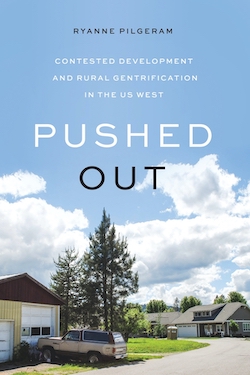 Much attention has been paid to gentrification and its attendant social and economic consequences in urban neighborhoods. Critics cite higher housing costs, cultural change, and displacement as reasons to resist redevelopment and the in-migration of new, wealthier residents to historic Black and brown neighborhoods. The poster children for these fears, such as Chelsea in New York City or Boyle Heights in Los Angeles, are usually located in dense, urbanized areas near the city's core that have once again become desirable.
Much attention has been paid to gentrification and its attendant social and economic consequences in urban neighborhoods. Critics cite higher housing costs, cultural change, and displacement as reasons to resist redevelopment and the in-migration of new, wealthier residents to historic Black and brown neighborhoods. The poster children for these fears, such as Chelsea in New York City or Boyle Heights in Los Angeles, are usually located in dense, urbanized areas near the city's core that have once again become desirable.
But cities aren't the only places vulnerable to the forces of gentrification. In the last two years, the acceleration of remote work has allowed for an unprecedented dispersal of workers who find themselves suddenly free from the confines of major cities, and many fled to far-flung rural communities and small towns far outside of metropolitan areas. These new migrants no doubt helped contribute to the steep rise in housing costs seen during the pandemic, but the changes they bring to their new communities impact far more than real estate prices.
Even before COVID-19 made it easier than ever for many people to move away from urban centers, rural American towns were experiencing their own version of gentrification. Rural communities, many created as extractive colonies to exploit natural resources and now struggling to remain economically viable, are seeing drastic changes as new residents move in and development alters long-standing social and economic relations. In Pushed Out: Contested Development and Rural Gentrification in the US West, Ryanne Pilgeram explores the phenomenon of rural gentrification through the lens of her hometown in northern Idaho. Pilgeram provides a detailed window into the historical and institutional forces that led Dover, a former mill town, to approve a controversial redevelopment project after the collapse of the town's economic base.
Pilgeram weaves together history, interviews, legal documents, and planning theory to describe the redevelopment of Dover and analyze the complex processes that drove the redevelopment. Using David Harvey's "spatial fix" theory, which centers geographic expansion as necessary to the growth of capitalism, Pilgeram positions Dover's story as "not an aberration but rather the product of a capitalist system reorganizing its exploitation of human and natural resources."
Pilgeram's close examination of one town's trajectory illuminates patterns present across the American West and the country in general, patterns of exploitation and disinvestment that leave entire communities floundering, often stripped of power and resources. Pushed Out sheds light on the transition being made––willingly or not––by small towns and rural communities that can no longer rely on their original, extractive economic base. In this way, the book is a timely reminder that the forces that drive urbanization, economic development, and migration affect communities far beyond the boundaries of major metropolitan areas.
Honorable Mention
New Mobilities: Smart Planning for Emerging Transportation Technologies
Todd Litman
Island Press
June 2021
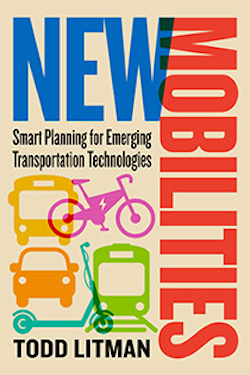 2020 was a big year for Planetizen contributors writing and publishing books, and 2021 continues the trend with Todd Litman’s new book, New Mobilities. Like we did last year with books by Planetizen bloggers and Planetizen Courses instructors, we avoided a conflict of interest by leaving New Mobilities out of consideration for the official Top Books list.
2020 was a big year for Planetizen contributors writing and publishing books, and 2021 continues the trend with Todd Litman’s new book, New Mobilities. Like we did last year with books by Planetizen bloggers and Planetizen Courses instructors, we avoided a conflict of interest by leaving New Mobilities out of consideration for the official Top Books list.
But that doesn’t mean we wouldn’t recommend New Mobilities to visionary planners. When Litman talks about new mobilities, he’s not just talking about new ways of getting around on two wheels, but much bigger innovations: new planning paradigms, new goals, and new consequences. Planetizen readers who have no doubt encountered Litman’s writing frequently will find a familiar tone and approach: thoroughly cited references, tables and infographics for illustration, and a reasoned rejection of the status quo. As much as any book on this list, New Mobilities keeps the focus on what it all means for planning, and how the field of planning can and should change as a result of technological innovations.

Planetizen Federal Action Tracker
A weekly monitor of how Trump’s orders and actions are impacting planners and planning in America.

Chicago’s Ghost Rails
Just beneath the surface of the modern city lie the remnants of its expansive early 20th-century streetcar system.

Amtrak Cutting Jobs, Funding to High-Speed Rail
The agency plans to cut 10 percent of its workforce and has confirmed it will not fund new high-speed rail projects.

Ohio Forces Data Centers to Prepay for Power
Utilities are calling on states to hold data center operators responsible for new energy demands to prevent leaving consumers on the hook for their bills.

MARTA CEO Steps Down Amid Citizenship Concerns
MARTA’s board announced Thursday that its chief, who is from Canada, is resigning due to questions about his immigration status.

Silicon Valley ‘Bike Superhighway’ Awarded $14M State Grant
A Caltrans grant brings the 10-mile Central Bikeway project connecting Santa Clara and East San Jose closer to fruition.
Urban Design for Planners 1: Software Tools
This six-course series explores essential urban design concepts using open source software and equips planners with the tools they need to participate fully in the urban design process.
Planning for Universal Design
Learn the tools for implementing Universal Design in planning regulations.
Caltrans
City of Fort Worth
Mpact (founded as Rail~Volution)
City of Camden Redevelopment Agency
City of Astoria
City of Portland
City of Laramie





























